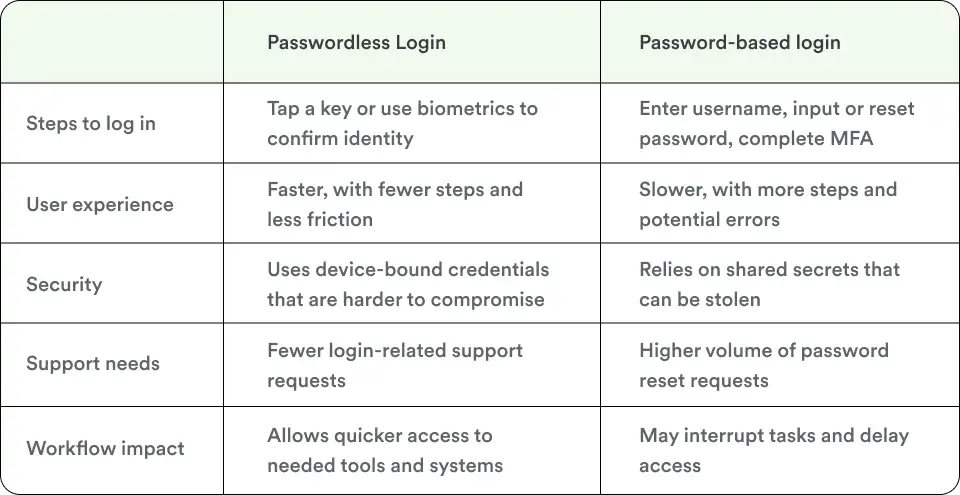5 Passwordless authentication benefits you shouldn’t ignore
Tired of juggling password resets and security concerns? Passwordless authentication offers a smarter way to log in. It strengthens security, lowers IT workload, and creates a smoother sign-in experience for your team—just a few of the passwordless authentication benefits worth exploring.
Key takeaways
- Passwords are hard to manage and easy to exploit. Switching to a password-free approach helps your team work more securely with less friction.
- Passwordless login methods reduce phishing risk and give users faster access to the tools they need.
- The passwordless authentication benefits are clear: stronger protection, fewer IT tickets, and a better experience for everyone.
- Start with the right solution, roll it out in phases, and keep fallback options available for when flexibility matters.

The problem with passwords
Passwords have long been the default for user authentication, but they no longer meet today’s needs. They are difficult to manage, often forgotten, and frequently reused across accounts. That makes them a common target for phishing, credential stuffing, and other attacks that rely on weak or stolen credentials.
For users and IT teams, password resets are frustrating and time-consuming. They interrupt work, increase support volume, and pull focus away from more valuable tasks.
It is a system full of friction. And it is time to move on.
Passwords create unnecessary risk
Password-based authentication depends on static credentials that are easy to compromise. Attackers take advantage of this with phishing, password reuse, and brute-force attempts.
These threats do more than cause security headaches. They lead to breaches, downtime, and recovery costs that no modern organization should have to face.
Passwords slow everyone down
Even when they work, passwords take up time. Users forget them. IT resets them. Work slows down.
Managing multiple accounts, remembering unique credentials, and meeting complex requirements create unnecessary barriers to productivity. Users fall back on unsafe habits, and IT teams stay tied up with avoidable issues.
Passwordless authentication removes that friction. Fewer support tickets. Faster access. More time to focus on what matters.
What are the key technologies behind passwordless authentication?
Passwordless solutions rely on modern standards and trusted technology. FIDO2 combines the WebAuthn API (browser side) with CTAP2 (client-to-authenticator protocol) to enable secure, phishing-resistant, passwordless logins using public key cryptography.
Hardware security keys, such as YubiKeys or Titan Keys, store credentials securely and provide an extra layer of protection. Biometric methods like Face ID, fingerprint scanners, and Windows Hello offer quick, secure verification.
Some authentication methods, like magic links and push approvals, are sometimes grouped under the passwordless umbrella. They can make logging in easier, but not all provide the same level of phishing resistance. Frameworks like FIDO2 and NIST 800 63 3 focus on methods that avoid shared secrets and offer stronger protection.

Top benefits of passwordless authentication
Passwordless authentication does more than remove friction. It strengthens security, streamlines access, and gives people a better way to get work done. The benefits are clear across industries and roles, and each one has real potential to improve everyday experiences at work.
Stronger protection against phishing and credential theft
One of the biggest advantages of passwordless authentication is that it stops phishing attacks before they start. Standards like FIDO2 with WebAuthn and CTAP2 use public key cryptography tied to a specific device. Since there's no password or shared secret, attackers have nothing to intercept or steal.
This approach protects against credential theft and credential stuffing because the credentials are never transmitted. Without access to the private key stored on the user's device, attackers cannot impersonate someone else—even if they try.
By eliminating passwords, organizations also eliminate one of the most common entry points for data breaches. Passwordless provides a safer way to validate user identities and maintain control over who gets in.
How this could look in practice:
At a small accounting firm, an employee receives a phishing email. With passwordless in place, there is no password to steal, so the attack fails before it starts.
No more MFA fatigue or prompt bombing
Attackers have adapted to some forms of multi-factor authentication—especially push-based methods—by launching “prompt bombing” or MFA fatigue attacks, flooding users with repeated notifications until one is approved by mistake. Passwordless authentication helps mitigate this risk by using device-bound credentials and silent cryptographic exchanges, eliminating the need for push prompts while still meeting MFA requirements behind the scenes.
Passwordless stops this behavior at the source. With no push prompts to spam, there’s nothing for attackers to exploit. Logins happen through a trusted device using secure, behind-the-scenes communication that confirms the user’s identity—no passwords, no approvals, and no guesswork. The process is invisible to the user and resistant to spoofing. Access is granted only to the right person, using the right device.
How this could look in practice:
In a busy support center, an agent avoids prompt bombing thanks to a phishing-resistant cryptographic exchange between their device and the server—no prompts, no approvals, and nothing the user has to touch.
Aligned with modern security standards
Passwordless authentication supports modern security frameworks like NIST 800-63B, CISA's guidance for identity and access management, and zero trust architecture. It helps keep access secure by continuously checking that the right person is signing in, no matter where they are or what device they’re using. For industries with strict compliance needs, passwordless also supports requirements like FIPS 140-2/3 and SOC 2 by using trusted encryption and making sure users are verified before they get access.
This is especially critical in industries like healthcare, finance, and government, where compliance depends on strong, secure authentication methods. Passwordless helps organizations stay ahead of threats while making it easier to protect what matters.
How this could look in practice:
At a healthcare clinic, providers use biometrics to access patient records quickly and securely, meeting compliance requirements without disrupting care.
Lower support costs and fewer reset requests
Password resets are one of the most common reasons users call IT. Eliminating passwords means fewer reset requests, which reduces help desk volume and lowers support costs. IT teams can spend less time on routine fixes and more time on strategic priorities.
Without the need to remember multiple passwords, users spend less time troubleshooting and more time getting things done. Passwordless authentication reduces login errors and cuts support volume—helping both users and IT work more efficiently.
How this could look in practice:
A design agency sees password reset tickets drop after switching to passwordless, freeing up IT to focus on more valuable work.
Faster, simpler access for users
Passwordless authentication makes it easier for users to gain access to the tools they need. Whether using biometrics, hardware tokens, or push notifications sent to a mobile device, users can verify their identity in seconds using their device—no password required.
This quick, low-friction process helps streamline logins, especially for employees who access multiple systems daily. When combined with single sign-on (SSO), passwordless authentication offers one secure, seamless way to log in across your environment.
How this could look in practice:
In a busy manufacturing plant, a shift supervisor signs in once with a fingerprint and gains access to every system they need for the day. No delays and no forgotten passwords.
Curious how Duo supports these benefits? Find out how Duo makes passwordless login simple and secure.
Passwordless vs. password-based login
Now that we've covered what passwordless can do, here's a look at how it compares to the login experience most teams still deal with today.

Start your passwordless journey
Moving to passwordless begins with understanding your environment, your users, and the options available. A thoughtful plan helps you roll out the right solution at the right pace and unlock the full value of passwordless authentication benefits.
Choose the right technology for your environment
The first step is selecting tools that align with your infrastructure and user needs. Your preferred authentication method may vary based on user roles, data sensitivity, and existing identity systems. Biometrics, security keys, authenticator apps, and other trusted options can all play a role. Choose what fits best.
Deploy in phases to drive adoption
A phased rollout helps you test, learn, and adjust. Start with pilot groups, collect feedback, and refine your approach before expanding. Clear communication and training make a big difference in long-term adoption and success.
Provide fallback options for edge cases
Even with strong adoption, some users may need alternatives. To support special cases without compromising security, plan for secure backups, such as limited-use passwords or one-time codes.
The passwordless future is here
Passwordless authentication delivers real and measurable benefits, from stronger security to lower support costs and a better experience for users and IT. By removing passwords from the process, organizations reduce risk, eliminate friction, and make access simpler.
Cisco Duo supports this shift with phishing-resistant solutions that fit your environment. Choose the right technology, roll it out in stages, and have fallback options ready when needed. Now is the time to build a more secure, efficient, and user friendly approach to authentication.
Want help planning your next step? Check out our five-step path to passwordless to see how to roll it out with confidence.
Ready to secure your organization?
Experience for yourself why Duo is one of the most trusted access management tools. Try it for free, explore editions, and connect with security experts.
